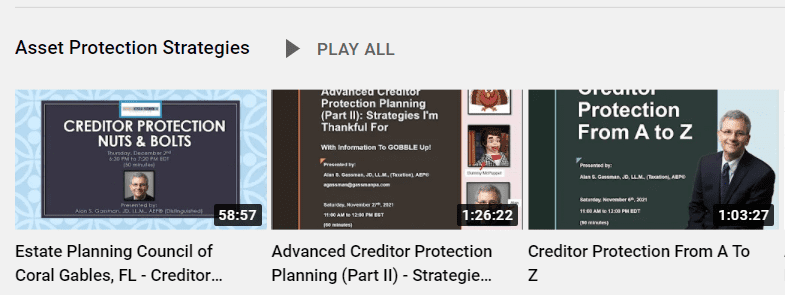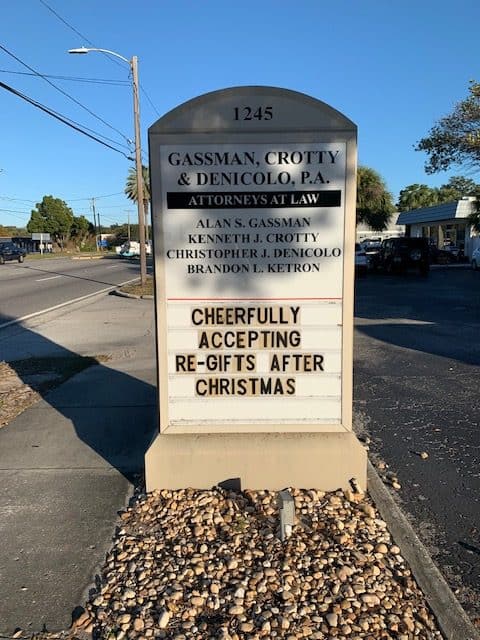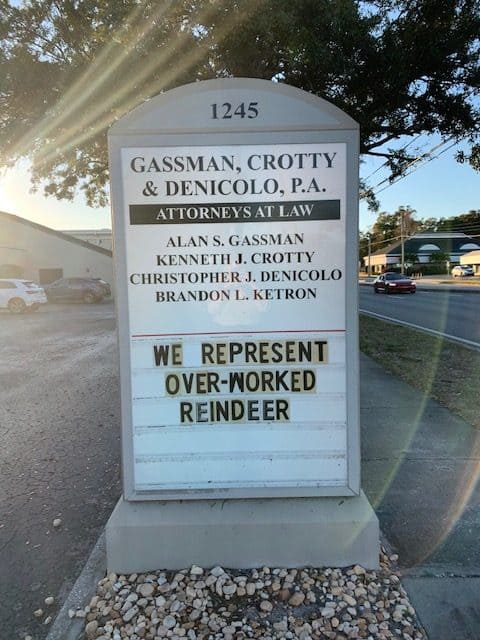The Thursday Report – Issue 320
|
|
|||||||||||||||||||||||||||||||||||||||||||||||||||||||||
Happy New Year!Thursday, January 6th, 2022Issue #320
Here’s to a phenomenal 2022, From the Thursday Report to you. May we all stay on target for our resolutions, For sure our Thursday Report will be emailing you solutions (or pollution). Now that the holidays are done, It’s time to turn the calendar from 2021. Best wishes from the state of the Sun. From the Law Offices of Gassman, Crotty & Denicolo, P.A. in Clearwater, FL Edited By: Christopher Denicolo
|
|||||||||||||||||||||||||||||||||||||||||||||||||||||||||
Article 1The Biden 3rd Step – What To Do With The Promissory Note Owed to the Grantor of an Intentionally Defective Grantor Trust (Part 2)READ PART 1 HERE; Written By: Alan S. Gassman, JD, LL.M, AEP (Distinguished), Brandon Ketron, CPA, JD, LL.M and Dakotah Flint Article 2Law Firm Slammed for Failure to Inform Judge of Existing LawU. S. District Judge orders over $40,000.00 in sanctions for failure to cite “long-standing settled caselaw” in motion for an injunction. Written By: Joseph Corsmeier, Esq. Article 3Disregarded Entity Rules For Limited Liability CompaniesWritten By: Alan S. Gassman, JD, LL.M, AEP (Distinguished) Article 4How to Complain to UberWritten By: Alan S. Gassman, JD, LL.M, AEP (Distinguished) and Dakotah Flint For Finkel’s FollowersAnxiety Is Common Among EntrepreneursWritten by: David Finkel; Author, CEO, and Business Coach Forbes’ CornerNew Stark Law – Will Doctors Be Caught NakedWritten By: Alan S. Gassman, JD, LL.M, AEP (Distinguished) Featured EventMore Upcoming EventsYouTube LibraryHumor |
|||||||||||||||||||||||||||||||||||||||||||||||||||||||||
Article 1The Biden 3rd Step – What To Do With The Promissory Note Owed to the Grantor of an Intentionally Defective Grantor Trust (Part 2)READ PART 1 HERE
Written By: Alan S. Gassman, JD, LL.M, AEP (Distinguished), Brandon Ketron, CPA, JD, LL.M and Dakotah Flint Dakotah Flint is a second-year law student at Stetson University College of Law and a Law Clerk at Gassman, Crotty & Denicolo, P.A. Special thanks to the Leimberg Information Services team for allowing us to re-print this paper. CITED AS: LISI Business Entities Newsletters: LISI Estate Planning Newsletter #2928 (December 21, 2021) at http://www.leimbergservices.com. Copyright 2021 Leimberg Information Services, Inc. (LISI). By way of background, the Biden Two-Step is a nickname used by the authors to describe a traditional installment sale to a defective grantor trust where a taxpayer establishes an irrevocable trust that is disregarded for income tax purposes and will not be subject to federal estate tax on his or her death, makes a seed capital gift to the trust, and sells one or more assets to the trust in exchange for a long-term, low-interest promissory note. The taxpayer can then decide to forgive or make a gift of all or a portion of the note, “undo” the sale by repaying the note or keeping the note in place. On December 20th, 2021 the authors released Part One of this article as LISI Estate Planning Newsletter #2927, which discussed the Biden Two-Step and reasons to leave, or not to leave, a promissory note in place. Part Two of this article picks back up where Part One left off discussing strategies and alternatives to forgiving the outstanding promissory note or simply leaving the note in place. On August 2020, in LISI Estate Planning Newsletter #2813 Alan Gassman, Jerry Hesch, and Marty Shenkman discussed how the well-established planning technique conventionally known as the Installment Sale to a Defective Grantor Trust can be combined with forgiveness of the note by gift in order to allow for flexibility, given the uncertainty of whether the estate tax exemption amount would be changed. The authors referred to this technique as the “Biden 2-Step,” and encouraged practitioners to consider transferring taxpayers’ assets into proper entities to facilitate an installment sale, while also selecting, establishing, and possibly refining, irrevocable trusts, and making seed capital gifts, as appropriate, before selling assets and entity interests to such trusts in exchange for long-term low-interest promissory notes. A YouTube video of Alan, Marty and Jerry discussing the Biden 2-Step can be viewed at: https://www.youtube.com/watch?v=4e7utgxtn7A. Part One of the Article previewed potential alternatives (aka the “third step”) for readers who are interested in something more than simply leaving the note in place, or forgiving or gifting all or a portion of the note which included the following: 1. Abort the Mission and Leave the Dance Floor By “Undoing” the Sale Transaction. 2. Transfer the Note to an Asset Protection Trust. 3. Convert the Note Into an Annuity 4. Use a “Zero’d Out CLAT. 5. Safely Gifting the Note – Wandry, Petter, Q-TIP, What’s Better? 6. Using the Exemption for a Qualified Personal Residence Trust Instead of Note Reduction. 7. Give the Note Some SCIN and Convert to a Self-Cancelling Installment Note. Option One – Abort the Mission and Leave the Dance Floor. Some taxpayers may elect to step back, meaning that they wish to reverse the process completely, and only entered the dance floor because they feared the exemption would revert to a lower amount, such as $5 million. Now that the exemption amount is not expected to be drastically reduced, at least for the next couple of years, that same individual wants a less complicated plan than the Biden 2-step. For example, an older, unmarried individual with $5 million worth of assets that wants to minimize his or her estate and related estate taxes can spend and gift significant amounts each year and invest primarily in fixed-income securities, such as bonds, to stay well below half of what the future forecasted exemption amount. This same individual would normally invest significant amounts in stocks and mutual funds, or income-producing real estate, but now he or she may feel comfortable holding fixed-income investments. The family financial planner may adjust the investment mix of the next generation, so that they have more in equities and less in fixed income, knowing that they will probably inherit the senior family member’s fixed income portfolio when she passes this to them upon death. If the next generation will be estate taxable, they would have been better off having the senior family member (“Senior”) invest in equities and engage in the Biden 2-Step, because what they inherit from Senior can be passed under Inheritance Trusts, which can benefit Senior’s family member’s children, grandchildren and great-grandchildren without ever being subject to federal estate tax at their levels. If Senior’s descendants also have no estate tax issues, then the strategy of having him invest primarily or entirely in fixed income assets, while family members invest in growth assets, may be sound, although it would seem better to allow Senior to invest in growth assets that would have a new fair market value income tax basis upon her death to the extent possible. Option Two – Transfer the Note to an Asset Protection Trust. A note could be transferred to an Asset Protection Trust that is considered to be an “incomplete gift” for federal estate and gift tax purposes by reason of the Grantor having the right to consent before any distribution can be made to any person other than the Grantor, and having a testamentary Power of Appointment. The Power of Appointment may be exercisable solely in favor of descendants of the Grantor, or perhaps up to 25% to future spouses, charities or other individuals or entities, and 75% solely for the descendants of the Grantor. While the note would still be includable in the Grantor’s estate for estate tax purposes, it would be protected from creditors of the Grantor, assuming that the law of the asset protection jurisdiction is controlling, and also from undue influence and “next spouse” claims as well. The trust could be drafted so that the Grantor could make the trust a “completed gift trust” by just renouncing the right to consent to distributions and the retained power of appointment, and at that time he/she will be considered to have made a complete gift of the assets under the trust to the Trustee, without further legal work and transfers being needed. Option Three – Convert the Note to an Annuity. Noteholders who live in states that provide creditor protection for annuities may wish to convert the note, in whole or in part, to an annuity right. In the 1988 Florida Bankruptcy Court case of In re Mart, an annuity arrangement payable to the grantor of a trust who transferred assets to the trust in exchange for the right to receive annuity payments was found to be an exempt asset under Florida Statute Section 222.14 for creditor protection purposes. The grantor filed for bankruptcy and was able to keep the right to receive payments from the trust while having the debt he owed discharged by the bankruptcy proceeding. Planners who draft documents such as Grantor Retained Annuity Trusts (GRATs) and Qualified Personal Residence Trusts (QPRTs) that will or may make annuity payments should review applicable state law to determine how such payments will be treated for creditor exemption purposes. For example, in the 2019 case of In re Resin (aka the Pink Hippo case) Cayman Island annuity contracts purchased by a trustee of an asset protection trust that was found to be penetrable by the south Florida Bankruptcy Court were held to be protected when the trustee purchased them and made them payable to the debtor without the debtor’s assistance. The Court found that the Florida fraudulent transfer statute did not apply where the debtor did not make the transfer and did not request that the trustee of a very old and cold trust to make the transfer. Alternatively, a note could be converted in whole or in part to a private annuity, subject to the possibility that the Probability of Exhaustion Test would need to be satisfied in order to avoid having a gift occur at the time of conversion. The Probability of Exhaustion Test under Section 7520 Treasury Regulations and Revenue Ruling 77-374 generally provides that the payor trust must have a sufficient net worth, and/or guarantors who pay guarantee payments, to assure that all annuity payments can be made until the payee reaches age 110, under the assumption that the assets available to satisfy the payments will grow only at the Section 7520 rate, which is 1.6% in December of 2021. For example, a Grantor age 70 making a seed capital gift of $1,000,000 to a Spousal Limited Access Trust (“SLAT”) could contribute $10,000,000 of assets to the SLAT and take back an annuity paying him $813,246.15 per year for life, or a 14 Year promissory note in the amount of $10,000,000 at 1.90% (based on the December long-term AFR) not self-cancelling, or 6.050% if self-cancelling. Self-cancelling installment notes are discussed in more detail below. Private annuity payments can be very flexible. They can be deferred and/or increase annually by a certain percentage. In the Kite case, Mrs. Kite contributed $10,605,278 worth of assets to her trusts in exchange for annuity payments that would begin ten years from the date of the transfer in the amount of $1,900,679.34 annually until the death of Mrs. Kite. In a recent private annuity structure, a 73-year-old wanted to have $2,400,000 a year to spend for the first nine years, and then the remaining payments for his lifetime would be based on the value of the assets contributed to the trust to avoid a gift. If the 73-year-old transfers $35,000,000 to the trust he could receive $2,400,000 for the first nine years, and $3,816,570 annually for his remaining lifetime. His wife will be well supported by the SLAT, which has over $92,000,000 in value. The taxpayer will continue to pay the income tax on income earned by the SLAT. There is sufficient assets in the trust to satisfy the Probability of Exhaustion Test, and the taxpayer’s estate can be kept under the remaining amount of his estate tax exemption to avoid federal estate tax. Option Four – The Zero Estate Tax Charitable Estate Plan — ConCLATulations The estate tax is a voluntary tax for those who don’t mind having a significant portion of their wealth going to public or family-controlled charities. Many clients who are owed large promissory notes may not be aware of the ability to transfer a note or other assets to a Charitable Lead Annuity Trust (“CLAT”) during life or upon death to qualify for a 100% estate tax gift or charitable deduction while expecting half or more of the assets involved to pass to be held for the benefit of family members after a term of years during which payments are made to one or more charities as determined each year by the family. The strategy of placing a promissory note into an LLC and then transferring the non-voting LLC interests to a CLAT has been approved by the IRS in multiple Private Letter rulings. For example, in Private Letter Ruling 201907004, the IRS ruled that the self-dealing rules would not prevent an individual who established and funded a CLAT from contributing a promissory note that was owed to him as the result of a sale of assets to a trust for the taxpayer’s descendants. The note had a 30-year duration and paid interest only until it ballooned at the end of the 30th year. The 1% voting member interest in the LLC that received the note was held by the Grantor’s daughter as trustee of an irrevocable trust for the Grantor’s descendants. The Grantor’s 99% non-voting member interest in the LLC was the sole asset conveyed to the CLAT, and the only assets owned by the LLC were the note and a small amount of cash that was expected to be sufficient to pay for administrative costs relating to the LLC. It is noteworthy that a discount taken in valuing a 99% LLC interest transferred to a CLAT causes a reduction in the annual payments to the charitable organization, as compared to what the payment would be if the promissory note could be transferred directly to the CLAT, without discounts. Nevertheless, if the discount taken exceeds what would by the Tax Court or Court of Claims for estate or gift tax purposes there should be an automatic adjustment, so that the payments to the charity would be increased retroactively, with interest, leaving less for the non-charitable family members, but eliminating estate or gift tax exposure in a manner similar to what occurs with a Grantor Retained Annuity Trust (GRAT). It is also noteworthy that the client who makes a contribution to a CLAT during his or her lifetime can receive an income tax deduction equal to the value of what is transferred to the CLAT, but must then include income recognized by the CLAT in income for the remaining CLAT remainder term. The authors do not know if a note that is disregarded for income tax purposes will be accepted by the IRS as being an asset that would be tax-deductible if gifted, but an LLC interest that is treated as a partnership interest for income tax purposes should be. The words “zeroed out,” means that the present value of the annual payment rights to the charitable organization equals 100% of the value of the CLAT, based upon the discount factors set forth in IRC Section 7520 and Treasury Regulations thereunder. Using commercially available software, such as NUMBER CRUNCHER or TIGER TABLES, a tax professional can determine an annual percentage of the value of the CLAT that can be paid to charity as a fixed annual payment.[i] Alternatively, better results can be achieved by using the 120% payment structure that was approved by PLR 201216045, and are permitted under the Grantor Retained Annuity Trust (“GRAT”) Regulations, so that each annual payment is increased by 20%. For example, if the LLC interests transferred to a zeroed-out CLAT is valued at $10 million upon inception for a term of 15, followed by having the remainder of the CLAT assets held in trust for descendants when the 7520 rate is 1.6% (as it is upon writing this letter) then the first annual payment will be $165,131.22, the fifth payment will be $342,416.10, the tenth payment will be $852,040.82 and the fifteenth payment will be $2,120,150.22. Sharky and the Machine. A more aggressive form of CLAT that requires customized calculations would pay only $1,000 a year for the first fourteen years, and then a final full payment in the fifteenth year. This is known as a “SHARK-FIN CLAT,” and is theoretically possible, and apparently, somewhat common in practice.[ii] Mathematical analysis performed by Professor Jerry Hesch, and others, lead to the conclusion that the financial results to be realized under a 20% per year increase in CLAT payment are not significantly better than the use of a SHARK-FIN CLAT, especially when taking into consideration that the IRS may challenge SHARK-FIN CLATS, but is unlikely to challenge their previously published opinion in a PLR related to the 20% annual increase in payments. If the note is owed to the CLAT by a Defective Grantor Trust, and the CLAT is also disregarded for income tax purposes as a “Grantor CLAT,” then there should be no income recognized when the note payments are made to the LLC to enable the LLC to make payments to the charitable organization. CLATs can be terminated early by having all payments that would have gone to the charity made at the time of termination, without any discount. If the Grantor of CLAT would like to see the charitable purposes that are being funded completed earlier or is concerned that death during the term of the CLAT could cause a significant income tax event, then termination of the CLAT during the Grantor’s lifetime can be a good planning idea. Commonly, this occurs when the younger family members would like to see charitable organizations and purposes funded from the CLAT assets, instead of from ongoing charitable donations from the family, and when the next generation would also like to have possession and use of what remains after the final charitable payment for their own purposes. Option Five – Safely Gifting the Note – Wandry, Petter, Q-TIP, What’s Better? When there has been an installment sale to a Defective Grantor Trust in exchange for non-voting membership or limited partnership interests, the remaining estate tax exemption of the taxpayer may be in doubt. For example, if the taxpayer made a seed capital gift of $5 million to a Defective Grantor Trust and then sold 99% non-voting LLC member interests in a company holding $75 million of assets in exchange for a $50 million 20-year low interest promissory note, a $5 million gift may have been reported, but upon audit the IRS might conclude that the 99% non-voting membership interest in the LLC was worth $55 million instead of $50 million, and that the taxpayer has made a $5 million gift, and will therefore only have $2,060,000 of estate tax exemption in 2022 as opposed to $7,060,000. If the taxpayer files a gift tax return in 2022 that fully discloses the $5 million gift and the installment sale, then the IRS will have until three years after the filing of the return (2025) to audit the return. Should the taxpayer therefore wait until after the statute runs in 2025 before making a gift of any portion of the note? Alternatively, can the taxpayer safely use a formula clause transfer, or a lifetime QTIP Trust arrangement to gift as much of the note as possible without triggering gift tax? The answer is “most likely” with a formula transfer note, and “almost definitely” with a lifetime QTIP. A formula transfer of a note can be based upon a conveyance document, which basically provides that “I hereby give a percentage ownership in the attached note, based upon a fraction, the numerator of which is $10,000 less than my remaining federal gift tax exemption, and the denominator of which is the face value of the note. For example, if the taxpayer’s remaining exemption turns out to be $4 million in the above example, and there is a $50 million note, then if there is no discount for a partial interest in the note or to take into account that a low-interest note is worth less than its face value, then $4 million divided by $50 million is 8% of the note that will be considered as transferred. On the other hand, if there is a 20% discount because of the duration and low interest rate of the note, then 80% of $50 million is $40 million, and if there is a 15% discount to take into account that a fractional interest in a note is not worth as much pro-rata as a separate and distinct part of a note, the combined discount would be 32% and a portion of the note that is worth $4 million would based upon $5,882,352 divided by the total face amount of the note.[iii] Will fractional transfers like this be approved by the Tax Court? While we have the benefit of the Wandry decision, and now the Nelson decision[iv], both of these were Tax Court Memorandum decisions, which have no precedential value, but certainly show us what certain Tax Court judges are thinking. The safer approach for a fractional transfer is still to use the McCord/Petter charitable overflow arrangement, which was found by the Ninth Circuit Court of Appeal to not be against public policy. Under this arrangement, the note transfer can be something like the following: I hereby transfer one-tenth (1/10) of one percent (1%) of the Forty Million Dollar ($40,000,000) note to the ABC COMMUNITY FOUNDATION, and a percentage of the note, as determined by the appraisal firm of DEF APPRAISERS to be worth an amount equal to the lesser of (1) $11,700,000 or (2) my otherwise remaining estate tax exemption to the ABC TRUST, and retain the remaining portion of the note. If the value of the portion of the note passing to the ABC TRUST as finally determined for federal gift tax purposes exceeds my gift tax exemption amount, then the excess shall go to the ABC COMMUNITY FOUNDATION. It may be important to use a public charity so that the self-dealing rules are not a concern. The QTIP Statutory Solution. Another method of transferring a note to use estate tax exclusion without any significant risk of incurring gift tax is available for married Grantors who do not mind benefitting their spouses. A Qualified Terminal Interest Property Trust (“QTIP”) is a trust that must pay all income and may pay principal to the spouse of the Grantor, and can qualify for the federal gift tax marital deduction. The primary advantage of the lifetime QTIP with respect to a difficult to value transfer is that the Grantor can make a statutorily recognized formula marital deduction election to treat a designated portion of the QTIP Trust as qualifying for the estate tax marital deduction while leaving a portion of the QTIP Trust to be considered to be a gift that would use part of the Grantor’s exemption. The formula election is provided in the statute and regulations, and is therefore full-proof, if properly implemented. The downsides of this technique are: (1) The portion of the QTIP that will be outside of the Grantor’s estate must pay income to the surviving spouse, and will therefore be a bit “leaky,” unless it owns assets that do not yield income, and (2) The arrangement may seem a bit complicated. (3) A portion of the note passing to qualify for the marital deduction may provide more benefits for a spouse than the Grantor intended. Advantages are (1) creditor protection, and (2) next spouse/undue influence protection, and (3) in some states the donor can become the beneficiary of the trust after the death of the spouse/beneficiary and not be considered to be a contributor to the trust for creditor protection purposes if the donor can only access assets as needed for health, education, maintenance and support, or with the consent of an unrelated trustee who the donor may appoint, subject to appropriate language and constraints. Here is an example of how this would work, based upon the previous example: The taxpayer still has a $50,000,000 promissory note, and expects to have a $7,060,000 estate and gift tax exemption, after having made a $5,000,000 seed capital gift and sale to the defective Grantor Trust in the example above. The taxpayer transfers a 20% ownership interest in the $50,000,000 note, which would have a face value of $10,000,000, to a lifetime QTIP Trust for the taxpayer’s spouse, which will pay the spouse all income for the spouse’s lifetime, and can allow the Trustee to make principal payments to the spouse in the discretion of a Trustee who can be replaced by the Grantor at any time. The remainder interest of the QTIP Trust will not pass to the Grantor’s descendants. In 2022, the Grantor files a gift tax return and makes an election to have the QTIP Trust divide into QTIP Trust A and QTIP Trust B. QTIP Trust A will be equal to a fraction of the total QTIP Trust that is equal in value to the Grantor’s estate and gift tax exemption amount, which is thought to be $7,060,000. The remainder of the QTIP Trust will be known as QTIP Trust B, and will qualify for the federal estate tax marital deduction. QTIP Trust A can be generation-skipping tax-exempt, based upon the use of the Grantor’s GST exemption. QTIP Trust B may pass as a GST exempt asset, if the spouse/beneficiary elects to have the spouse’s GST exemption allocated to the Trust in what is called a reverse QTIP election. As the result of the above, the two QTIP Trusts are administered based upon the appraiser’s conclusion that the note can be discounted 20%, because it has a long term and a low interest rate, and therefore valued at $8,000,000 for gift tax purposes, so that 17.65% of the note is allocated to QTIP Trust A, and 2.35% is allocated QTIP Trust B. The IRS may audit the 2021 gift tax return and come to the conclusion that the note is worth its face amount, and that there should be no discount for any purposes. If the family chooses to not disagree with the IRS because of other issues that might arise in the audit, then the note may shift to be considered as owned 14.12% by QTIP Trust A and 5.88% owned by QTIP Trust B. At some point, the Trustee of QTIP Trust B may transfer its 2.35% of the note to the Grantor’s spouse, who may elect to transfer the note to joint names between the Grantor’s spouse and the Grantor. That portion of the note might be paid in full after four or more years from the conveyance of the note to the QTIP Trust B, and the remaining portion of the note may also be paid in full, so that QTIP Trust A may invest in growth stocks that pay very little in dividends, and the family can live happily thereafter. Option Six – Using the Exemption for a QPRT Instead of Note Reduction. Other alternative uses of the taxpayer’s gift tax exemption may be considered. For example, if the taxpayer’s homestead is expected to grow in value or at least retain its value, and the Grantor is expected to live for longer than the period chosen as the retained use interest, then use of part of the taxpayer’s gifting allowance for one or more QPRTs that can own all or a part of the taxpayer’s primary residence and one other personal residence, can be the most effective use of gift tax exemption. For example, an individual age 60 may own 50% of a homestead worth $2,000,000 with her spouse owning the other 50%. Assuming a 15% discount that may apply for a 50% interest, and a 10 year retained use interest, the gift of half of the homestead to a QPRT would use $619,250 of the taxpayer’s gift tax exemption, but the entire 50% ownership of the home would be excluded from federal estate taxes, if the taxpayer dies after the 10-year term. If the home grows at 3.5% a year in value and the taxpayer dies in year 20, then 50% of the home would at that time be worth $3,652,753 and would be excluded from the taxpayer’s estate, in addition to rent that the taxpayer would pay to use the home in years 11 through 15. If rent is based upon 8% of the value of the home, and able to be reinvested at a 7% rate of return then the total estate tax savings would be $2,289,966. Alternatively, half of the home could be sold for an installment note to a trust and the taxpayer could pay one-half of the fair rental value of the home in order to have use thereof. If the home is placed in an LLC, and the taxpayer retains a 1% voting member interest and sells a 99% non-voting member interest in the LLC in exchange for the note, this may yield a better economic result, but is harder to understand, and could cause loss of state law homestead TAX advantages. A homeowner in Florida could use either technique and still maintain the Florida homestead tax exemption, and have the advantage of the 2% per year cap on the increase in assessed value by using a 98-year or longer lease with fair market value rent. Option Seven – Give the Note Some SCIN Another advantage of keeping the note outstanding is the ability to maintain or convert it to a self-cancelling installment note, in whole or in part, so that the death of the Grantor or the Grantor’s spouse can cause the note not to be included in the Grantor’s estate, without having to use the Grantor’s estate tax exemption to reduce or eliminate it. For example, if the Grantor is age 60 and the note issued in November of 2021, then the long-term applicable federal rate is 1.86%, and the premium rate to facilitate the self-cancelling installment note that will become due and payable on the grantor’s 21-year life expectancy based on the 2000CM life expectancy tables will be 2.278%, for a total of 4.138% interest. If the Grantor dies during the 21 year period, then the note is canceled, and the family is much better off if the Grantor would otherwise be estate taxable. If the Grantor has a health condition or family history that would cause it to be more probable than not that death would occur before the balloon, then this could be a good strategy. Until the IRS took the position in the Tax Court case of Estate of Davidson[v] that the standard life expectancy tables cannot be used in structuring a self-cancelling installment note, most practitioners and commentators were of the opinion that a self-cancelling installment note can be structured without gift risk, if the noteholder had a better than 50% chance of surviving at least one year after the note is issued, or, in fact, survived at least 18 months, because of Treasury Regulation §25.7520-3(b)(3), which applies these standards when assets are sold for a private annuity contract. A promissory note is very much like a private annuity, because it provides for fixed annual payments that are clearly measurable at the time that the note is issued. The Davidson case was settled, so there may be no authority that a note cannot be structured with payments that would analogized to a private annuity, while using the better than 50% chance of survival standard. The terminal illness requirement under the Section 7520 Treasury Regulations prevents use of normal life expectancy assumptions, if there is a “terminal illness,” which is an incurable illness or other deteriorating physical condition that causes the transferor to have a 50% or higher probability of dying within one year. “Individuals suffering from the general infirmities of old age, but not from a specific, incurable life-threatening illness” are not considered to be terminally ill under the regulations. If an elderly person has one or more illnesses, none of which standing alone are considered to be life-threatening, then that person would not be considered terminally ill. Several serious diseases and conditions, such as heart disease, diabetes, many forms of cancer, and Alzheimer’s Disease, do not automatically reduce life expectancy to a 50% probability of death within one year, until these afflictions have progressed to advanced stages.”[vi] Families who are concerned about the possibility of paying gift tax at the time that a SCIN is entered into can consider the SCGRAT strategy discussed in LISI Newsletter #2230 (June 3, 2014), whereby the Grantor places valuable assets in an LLC that is owned by the Grantor. The LLC gives the Grantor a self-cancelling installment note, which causes the value of the LLC to be very small, if the promissory note is worth its face amount. The Grantor then gifts the 99% non-voting member interest in the LLC and some cash or marketable securities to a “zeroed out” Grantor Retained Annuity Trust (“GRAT”) in exchange for the right to receive two annual payments. Each payment will be worth approximately 51.20% of the day one value of the LLC as of the moment that it was transferred to the GRAT. The payment can be satisfied by paying cash that the LLC can distribute to the GRAT or in the form of assets equal in value to such amounts that the LLC may distribute to the GRAT each year. When the Grantor has established one or more Defective Grantor Trusts, such trusts may transfer cash to the GRAT in exchange for LLC interests, so that the GRAT has money to use to pay to the Grantor as scheduled. If it turns out that the self-cancelling installment note has a very small value, then the Grantor will be owed larger payments from the GRAT, and no gift tax will be due. The possibility that a Grantor, who is diagnosed with a condition that dramatically reduces life expectancy, can convert a promissory note to be self-cancelling can be a significant advantage to maintaining the note. Conclusion Taxpayers who have taken the first step in selling assets to disregarded trusts in exchange for promissory notes have many opportunities and possibilities to consider in determining whether to terminate or have the note repaid. For estate tax planning purposes, the best result may be facilitated by forgiving the note, but not always. Practical concerns such as marital rights, creditor protection, and whether a commitment should be made. The following is a recent sample letter that may be used to pass these considerations along to your clients:
______________________________________________ [i] Or call a friend! [ii] FINS TO THE LEFT FINS TO THE RIGHT AND YOU’RE THE ONLY CLAT IN TOWN, SHE CAME DOWN FROM CINCINNATI. WHILE READING LISI LETTERS THAT GET NO BETTER, LOOKING TO TRY TO AVOID ESTATE TAX. SHE HIRED A LAWYER NAMED REMORA, AND A CPA NAMED JAKE. THEY ARRANGED TO PUT THE NOTE INTO A CLAT, AND THEN DRANK TEQUILA BY THE SALT LAKE. [iii] $5,882,352 multiplied by 80% multiplied by 85% is $4 million. [iv] The taxpayer lost the Nelson decision due to the fact that the attempted adjustment of the percentage transferred by the taxpayer after an audit, indicated that the value would be “as determined by a qualified appraiser within ninety days of the effective date of this Assignment,” as opposed to the established cases which featured transfer instruments that defined the interests transferred as the “fair market value as finally determined for federal gift and estate tax purposes.” [v] Tax Court Docket No. 013748-13 (filed June 14, 2013) [vi] The quotation comes from the Bloomberg BNA Porfolio 85-3rd entitled Private Annuities and Self-Canceling Installment Notes by Edward P. Wojnaroski, Jr., Esq. ______________________________________________ Want to learn more? Join Alan and Brandon for a 90-minute video on this topic. Leimberg Webinar Services Recording and Slides are available for purchase by clicking the link below. WATCH NOW
|
|||||||||||||||||||||||||||||||||||||||||||||||||||||||||
Article 2Law Firm Slammed for Failure to Inform Judge of Existing LawU. S. District Judge orders over $40,000.00 in sanctions for failure to cite “long-standing settled caselaw” in motion for an injunction.
Written By: Joseph Corsmeier, Esq. Hello everyone and welcome to this Ethics Alert, which will discuss the recent Oregon U.S. District Court Judge’s Order requiring the law firm of Davis Wright Tremaine and one of its partners to pay over $40,000.00 in sanctions for failing to mention “long-standing, settled caselaw” that prevented the judge from issuing an injunction that was sought by the law firm. The 6-page December 16, 2021 Court Order is here: https://s3.documentcloud.org/documents/21164070/mcshanesanctionslawyerfirmliable.pdf. The Davis Wright law firm had represented St. Charles Health System Inc. in an attempt to prevent a strike by 156 medical technicians and therapists. Davis Wright partner Mark Hutcheson sought an injunction to prevent the strike, even though a district court has no jurisdiction to issue an injunction in those circumstances and only the National Labor Relations Board has authority to seek an injunction to prevent an unfair labor practice under the National Labor Relations Act. Judge Michael McShane of the U.S. District Court for the District of Oregon sanctioned the law firm and firm partner Mark Hutcheson and required the payment of $40,625.00 for the opposing party’s legal fees. The judge found that the failure to disclose was “an attempt to deceive the court via a material omission.” The judge further found that the motion was filed in bad faith for an improper purpose to gain a negotiating chip in the hospital’s discussions with the union representing the workers. “Had the defense not cobbled together a quick brief, the court was prepared to issue a completely illegal order based on the law as presented by the hospital; law the court later learned to be a fiction.” The Order states that the lawyer and law firm “essentially argue that although in hindsight they could have done more to alert the court of binding, contrary precedent, their actions are not sanctionable because they were merely arguing for an ‘extension’ of existing case law and were unable to identify any case ‘on all fours’ with the underlying facts here.” “This explanation is meritless.” Bottom line: This is an example of a court’s application of the Bar Rule which requires lawyers to identify and disclose legal authority in the controlling jurisdiction known to the lawyer to be directly adverse to the position of the client and not disclosed by opposing counsel. The lawyer’s failure to disclose the legal authority in this matter resulted in civil sanctions and could also result in an investigation and potential disciplinary sanctions. Florida Bar Rule 4-3.3(a)(3) sets forth this requirement and is below: RULE 4-3.3 CANDOR TOWARD THE TRIBUNAL (a) False Evidence; Duty to Disclose. A lawyer shall not knowingly: (3) fail to disclose to the tribunal legal authority in the controlling jurisdiction known to the lawyer to be directly adverse to the position of the client and not disclosed by opposing counsel. Be careful out there. As always, if you have any questions about this Ethics Alert or need assistance, analysis, and guidance regarding ethics, risk management, or other issues, please do not hesitate to contact me. My law firm focuses on review, analysis, and interpretation of the Rules Regulating The Florida Bar, advice and representation of lawyers in Bar disciplinary matters, advice and representation of applicants for admission to The Florida Bar before the Board of Bar Examiners, defense of all Florida licensed professionals in discipline and admission matters before all state agencies and boards, expert ethics opinions, and practice management for lawyers and law firms. If there is a lawyer or other Florida professional license involved, I can defend the complaint or help you get your license. If you have any questions or comments, please call me at (727) 799-1688 or e-mail me at jcorsmeier@jac-law.com. You can find my law firm on the web at www.jac-law.com. In addition to handling individual cases, matters, problems and issues for my clients, I also am on retainer to provide ethics advice to numerous lawyers and law firms throughout the state of Florida. I also provide legal assistance and advice to numerous individuals and non-legal entities to help ensure compliance with the law and rules related to UPL and other issues. |
|||||||||||||||||||||||||||||||||||||||||||||||||||||||||
Article 3Disregarded Entity Rules For Limited Liability Companies
Written By: Alan S. Gassman, JD, LL.M, AEP (Distinguished) Under the IRS regulations, a limited liability company considered as owned by only one person or entity can be disregarded for income tax purposes. Under these regulations, the social security number or employer identification number of the applicable owner can be used for all accounts and activities of the “disregarded LLC.” For state law purposes, the LLC is considered to be a separate and independent entity and is well advised to have a separate bank account or accounts, separate insurances, and to function separately from a fiscal standpoint. Nevertheless, banks, brokerage houses, and other parties can be advised that the limited liability company will use the tax identification number of its owner/member. Where a husband and wife together own a limited liability company, this may also be considered a disregarded entity for income tax purposes and one of their social security numbers may be used, although the tax law is not absolutely clear on this. The IRS instructions to the Form 1065 Partnership Tax Return indicate that when a married couple who do not live in a community property state jointly own an LLC, the LLC should file a partnership tax return, but well-respected authorities believe to the contrary. Fortunately, there is an IRS Revenue Procedure that was published to confirm that failure to file a partnership tax return will not result in the imposition of any penalties or interest if the income associated with the arrangement is properly reported on the income tax return of the “partners.” It is also possible to establish irrevocable trusts that are disregarded for income tax purposes. In some cases, a limited liability company will be owned by an individual or a married couple and a trust that they have created. In such an event, since the trust is disregarded, the limited liability company may be disregarded as well.
|
|||||||||||||||||||||||||||||||||||||||||||||||||||||||||
Article 4How to Complain to Uber
Written By: Alan S. Gassman, JD, LL.M, AEP (Distinguished) and Dakotah Flint Dakotah Flint is a second-year law student at Stetson University College of Law and a Law Clerk at Gassman, Crotty & Denicolo, P.A. Uber is a smartphone app that was originally founded in 2009. Today, Uber is a platform that allows those who have a means of transportation to connect with individuals with a need for a service. Uber allows an individual the ability to request to be picked up by a driver and dropped off at their desired location, order food to be delivered, and several other services. Uber has grown to be available in over 10,000 cities across 72 countries and has over 109 million monthly active platform consumers. However, with Uber’s massive growth comes some growing pains for their consumers. With over 3.5 million drivers, it is not uncommon for a consumer to have a negative experience with Uber. For example, a ride service passenger may get into a vehicle with no seatbelts, with a reckless driver, or may never get into a vehicle at all because the driver has left them out in the cold waiting for a ride that will never come. Consumers that order food delivery from Uber also encounter negative experiences. Some will receive the wrong order, others will receive food that has already been opened and eaten, or if they’re one of the lucky ones, just some cold and soggy fries. As a lawyer, I am often asked what recourse people have when Uber leaves them high and dry from a ride or delivery, which is commonly happening. Unfortunately, I could find no phone number and no way to contact Uber on the Uber app. Thank heaven that a smart law student was able to put together this information, and even show me how I can complain on my app, assuming that someone from Uber on the other side will actually answer. Please note that Uber is a publicly-traded company known as Uber Technologies Inc, and according to their SEC filings, they have a board of directors consisting of 12 individuals who can be found at https://investor.uber.com/governance/default.aspx I was amused to see the word “default” as naming this group because by my rough estimate Uber is defaulting on promised rides and prompt meal deliveries thousands of times a day. I did not find a corporate ethics committee which is unusual for publicly-traded companies by my experience. Maybe Uber will someday form an ethics committee and will publicize the availability thereof, although that ethics committee may receive more mail than Santa Claus. Uber does have a conflict of interest policy that does not appear to prevent Uber employees from answering complaints if there is a way to communicate the complaint to them. Hopefully, the following will be of assistance to anyone who might otherwise need to hire a lawyer because their food was cold and delivered an hour late or they missed their appointment with their hairdresser because the Uber driver didn’t show up and no substitute was available. Safety First If you are using Uber’s ride service and you are sent a driver that doesn’t appear safe, for example, the car is missing seatbelts, the car is not the same car that Uber said was being sent, or the driver is someone different, don’t get into the vehicle. You are NOT required to take the ride once it was ordered. Thank the driver and tell them that you no longer need a ride and cancel the trip. To cancel the trip: 1. Tap the bar at the bottom of the screen that shows the Uber driver’s name and information. This will cancel your trip. Note: you may be charged a cancellation fee if the trip has already started. Rating the Driver/Delivery Person To rate your Uber driver: 1. Tap on your profile icon in the top right-hand corner of the app. An Uber driver is rated on a star rating from 1 to 5. The Uber driver’s rating that is displayed is the average rating that they received from the last 500 rides they gave. These ratings are given anonymously by their passengers. The driver will not be able to see who gave the rating. These ratings may have more of an impact on the driver than you may think. First, this rating is displayed to their potential passengers. If a driver has a poor rating, a passenger will be more likely to cancel their trip before pick up, causing the driver to miss out on the income from that ride. Uber also monitors a driver’s ratings. If a driver’s ratings drop below a 4.6, the driver runs the risk of having their account deactivated, removing their ability to earn income from Uber. Uber also uses these ratings to give the drivers different perks. The lower the driver’s rating, the fewer perks they will qualify for. Rating Your Uber Food Delivery Person To rate your Uber delivery person: 1. Tap on your profile icon in the top right-hand corner of the app. An Uber food delivery person’s rating comes from the results of their last 100 deliveries. Their rating is displayed as a percentage of customer satisfaction. After each delivery, a customer has the option to give the delivery person a thumbs up (satisfied) or a thumbs down (dissatisfied). Uber requires that food delivery persons maintain a certain satisfaction percentage otherwise that individual’s account runs the risk of deactivation. File a Complaint Whether it be with a driver or a delivery person, if you’ve had a more serious problem, you should consider making an attempt to file a complaint with Uber. Unfortunately, Uber no longer has a phone support line to aid their customers, so you are unable to call and speak directly to one of their employees. You used to be able to send a complaint directly to Uber via email to support@Uber.com, however, now, after you’ve spent several minutes carefully formulating an email about how your driver almost killed you by going the wrong way on the interstate, you will be greeted by an automated email informing you that you’ve reached an inbox that is no longer being monitored. Your only hope in trying to file a complaint with Uber is through their app by doing the following: 1. Tap on the profile icon in the top right-hand corner of the app. If you do not have access to the Uber app, you can also do this online at help.uber.com. Once you have submitted a request for support to Uber, they will make an adjustment to your bill if necessary, or if it is a serious enough problem, they will get into contact with you at their earliest convenience. |
|||||||||||||||||||||||||||||||||||||||||||||||||||||||||
For Finkel’s FollowersAnxiety Is Common Among EntrepreneursHere are 4 Tips To Help Sooth Your Nerves |
|||||||||||||||||||||||||||||||||||||||||||||||||||||||||
Forbes’ CornerDec 23, 2021 New Stark Law – Will Doctors Be Caught Naked
Written By: Alan S. Gassman, JD, LL.M, AEP (Distinguished) All medical practices that bill Medicare for services rendered must comply with the Stark Law regulations in order to be able to bill for “Designated Health Services” (DHS)…Continue reading this article on Forbes. Ready, Set, Go – For Stark Group Practice Compliance!REGISTER HERETuesday, January 11th, 2022 4:00 PM to 4:30 PM EST (30 minutes) An Update On New Stark Laws With Alan Gassman and Lester Perling Presented by: Alan Gassman, JD, LL.M., AEP® (Distinguished) and Lester Perling, Esq., CHC Lester Perling is a board-certified health law attorney and is certified in healthcare compliance. He has extensive experience in compliance, enforcement, and reimbursement matters. Lester’s practice focuses on advising healthcare providers of all types with regard to complying with federal and state laws, with emphasis on Stark law and reimbursement/billing compliance. After registering, you will receive a confirmation email containing information about joining the webinar. Approximately 3-5 hours after the program concludes, the video recording and PowerPoint presentation will be sent to the email address you registered with. Please send your questions and comments to agassman@gassmanpa.com. This program does not qualify for CLE/CPE Credits. THIS IS A FREE PROGRAM.
|
|||||||||||||||||||||||||||||||||||||||||||||||||||||||||
Featured EventFREE WEBINAR FROM OUR FIRMHow To Make Your Office Or Business More Effective And EnjoyableREGISTER HERESaturday, January 8th 11:00 AM to 12:00 PM EST (60 minutes) Presented by: Alan Gassman, Esq. After registering, you will receive a confirmation email containing information about joining the webinar. Approximately 3-5 hours after the program concludes, the video recording and PowerPoint presentation will be sent to the email address you registered with. Please send your questions and comments to agassman@gassmanpa.com. This program does not qualify for CLE/CPE Credits. THIS IS A FREE PROGRAM. |
|||||||||||||||||||||||||||||||||||||||||||||||||||||||||
ESTATE PLANNING SATURDAY SERIES WITH ALAN GASSMAN
|
|||||||||||||||||||||||||||||||||||||||||||||||||||||||||
More Upcoming Events
|
|||||||||||||||||||||||||||||||||||||||||||||||||||||||||
YouTube LibraryVisit Alan Gassman’s YouTube Channel for complimentary informational webinars and more! The PowerPoint materials can be found in the description box located at the bottom of the YouTube recordings. Click on the playlist below to watch the recordings.
|
|||||||||||||||||||||||||||||||||||||||||||||||||||||||||
Humor
The Thursday Report’s New Year’s Resolutions To not waste time reading The Thursday Report. To not waste time pledging not to waste time reading The Thursday Report. Travel forward in time as opposed to traveling back in time to re-live reading past editions of The Thursday Report. To try and find some humor for a change. To find change for a dollar to pay our writers.
|
|||||||||||||||||||||||||||||||||||||||||||||||||||||||||
|
Gassman, Crotty & Denicolo, P.A. 1245 Court Street Clearwater, FL 33756 (727) 442-1200 Copyright © 2021 Gassman, Crotty & Denicolo, P.A
|
|||||||||||||||||||||||||||||||||||||||||||||||||||||||||
Unsubscribe here




















